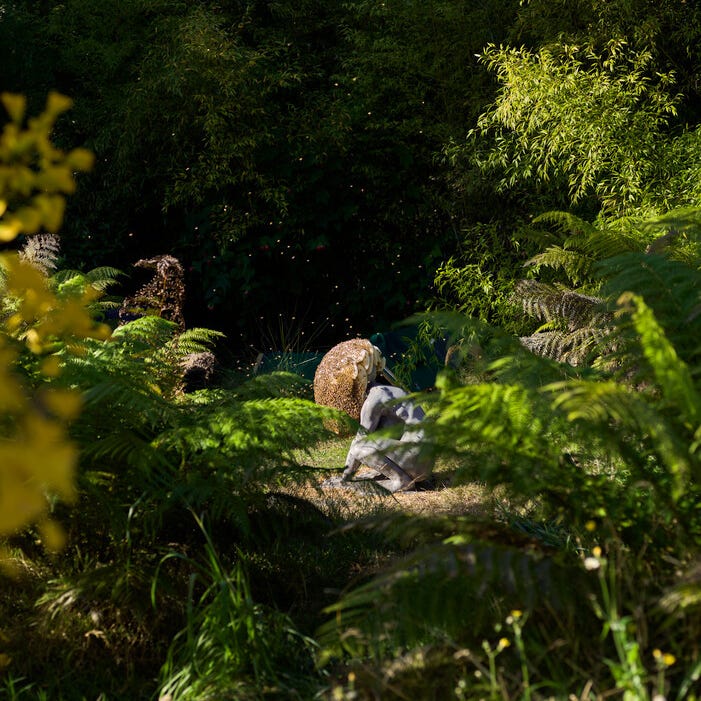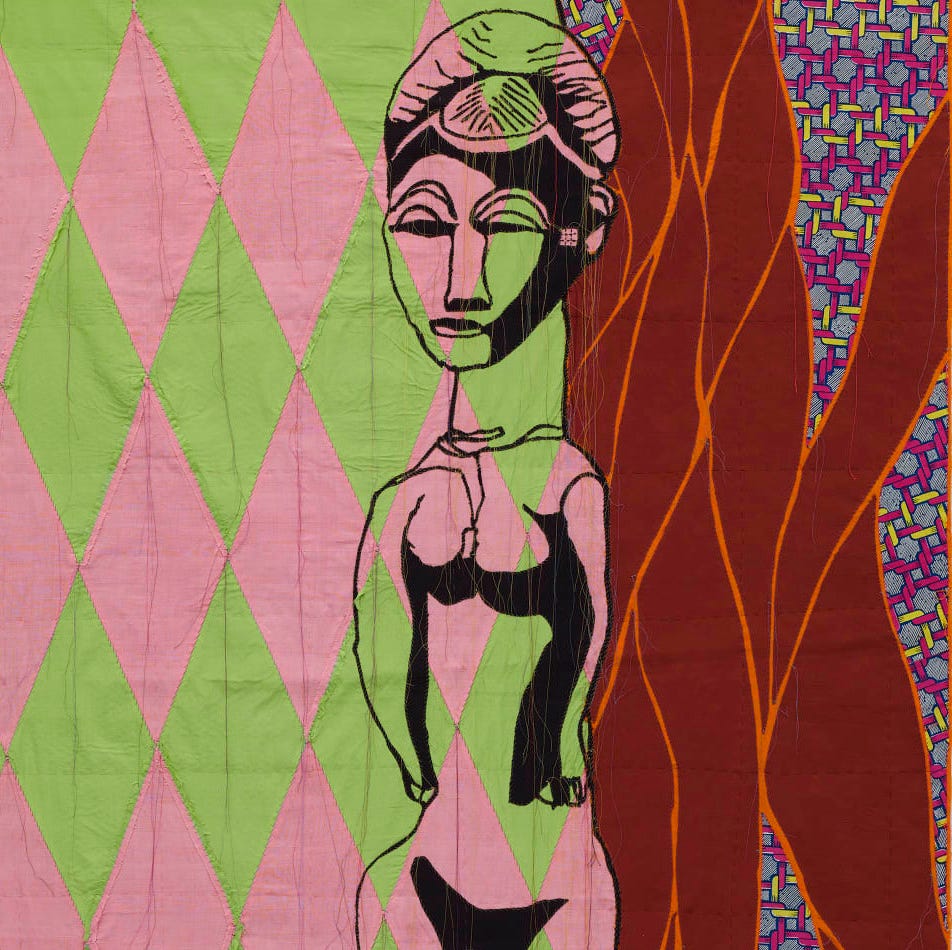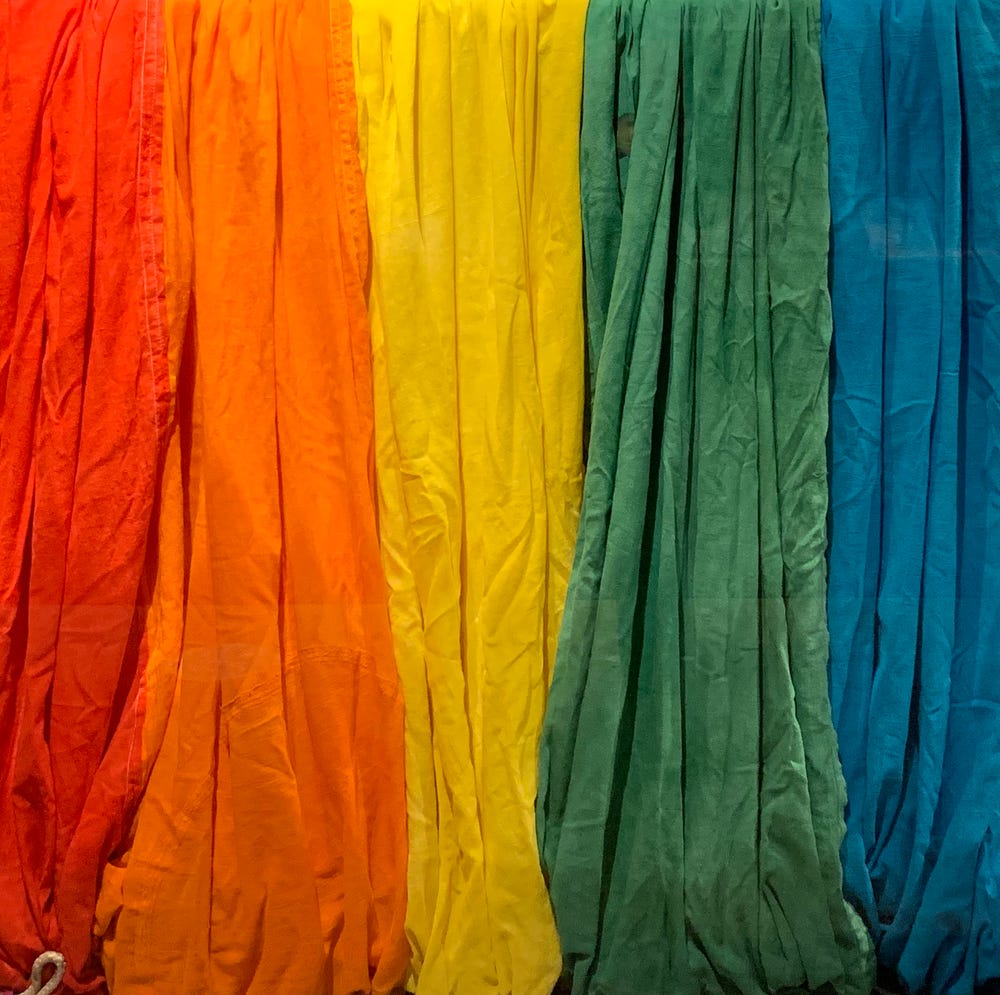How Leilah Babirye’s Sculptures Celebrate African Art + Queer Identity
By Kristen Stain, artist and designer; Ivy Mills, lecturer in the history of art, UC Berkeley; Salimatu Amabebe, chef and multimedia artist
August 29, 2024
Installation view of Leilah Babirye: We Have a History, de Young, San Francisco, 2024. Photograph by Gary Sexton
In presenting our permanent collection and special exhibitions, we aim to tell the most inclusive stories to the broadest audience. For Leilah Babirye: We Have a History, Natasha Becker (curator of African art), Abram Jackson (director of interpretation), and Devin Malone (director of public programs), worked with six interpretation partners, local Black artists and art historians specializing in queer African visual cultures, to interpret the exhibition in the most inclusive way. Below, three interpretation partners, Kristen Stain, Ivy Mills, and Salimatu Amabebe, share their insights on the artist and highlight key takeaways about the exhibition.
Installation view of Leilah Babirye: We Have a History, de Young, San Francisco, 2024. Photograph by Randy Dodson
Kristen Stain, artist + designer
Leilah’s incredible work and practice reflects an intuitive, ancestral knowing. Her relationship with herself and the materials she uses is one of loving inquiry and listening. Her ability to transmute personal and collective queer experiences through repurposing discarded objects, while also looking for the individual within each trunk of wood or mound of clay, is profound. Her work calls to the past and speaks to a more liberated future. Her works say, “we are here, we have always been here, and we will be here in the future.”
The work in proximity to the arts of Africa collection highlights that queerness has always been African and always had space in the sacred parts of precolonial Indigenous African life. It’s boundary-pushing and inspiring that she works without manufactured pottery tools. Instead, she employs coiling (a traditional hand-building technique in which she creates coils of clay which are formed, pushed, pinched, and layered to create a sculpture.) She is intentional about her relationship with each character she “meets” through her work, but leaves room for experimentation and surprise with her glaze combinations and application style. The adornments, braids, and jewelry have a whimsical, playful, and dress-up nature while being expertly finished.
Installation view of Leilah Babirye: We Have a History, de Young, San Francisco, 2024. Photograph by Gary Sexton
Ivy Mills, lecturer in the history of art, UC Berkeley
In the short film The Fearless Art Practice of Leilah Babirye, the artist kisses her sculptures and calls them beautiful. To accentuate their beauty, she creates elaborate hairstyles composed of bicycle chains, aluminum can tops, and other discarded (and sometimes rusty) materials, a process she calls “taking the girls to the salon.” In homophobic discourse in Uganda, LGBTQ+ community members are referred to as “abasiyazi” (sugar cane husks considered rubbish). Babirye’s recuperation of abandoned, “ugly” materials as beautifying elements is an assertion that the queer ancestors materialized by the sculptures are both lovely and beloved. They are worthy of care, attention, and pampering.
Babirye’s sculptures are unconventionally beautiful. The figures’ facial features can be rough, exaggerated, and asymmetrical. While the glaze and wax used suggest a polishing or refining of the skin, the bumps, holes, and cracks in the wood and clay remain visible. The excess glaze that drips down their faces further interrupts their shiny smoothness.
These choices resonate with recurring forms in the arts of Africa collection at the de Young. The historical sculptures that invoke ancestors and other immaterial beings have highly stylized, exaggerated features that suggest their spiritual power. While they have human-like characteristics, they are not meant to resemble living individuals. Large, bulging eyes, for instance, can signal the capacity to see beyond the physical realm into the metaphysical realm. Closed eyes can also suggest a powerful form of spiritual vision, as well as convey the ancestral force’s “coolness” (its ability to maintain balance, harmony, and self-control). Rough, rusty elements — like the nails and other sharp metal objects pounded into the body of the nkisi nkondi from the Kongo — activate forces channeled through the sculpture. Their sharp roughness, and the violence involved in inserting them, show that a menacing raw power may need to be harnessed in order to counter a similarly powerful and frightening force. The glaze dripping down Babirye’s ceramic faces echoes the glistening palm oil poured over the reliquary figures from Gabon. The ritual application of this substance is an essential step in the sculptures’ activation. It is a visual signal that they are agents that protect ancestral remains and enable communication with the deceased.
We Have a History’s resonances with works in the collection suggest the impact of Babirye’s sculptures lies not only in their beauty but also in their ability to channel the awe-inspiring power of queer ancestors. Her sculptures are not simply portrait-like representations of queer forebears. They are means through which the power of the metaphysical realm can be harnessed to serve struggles for justice and belonging in the present.
Installation view of Leilah Babirye: We Have a History, de Young, San Francisco, 2024. Photograph by Randy Dodson
Salimatu Amabebe, chef + multimedia artist
Listening is a key theme in We Have a History. In the farthest corner of the gallery, a short video provides insight into Leilah Babirye’s artistic practice. Wielding a chainsaw with the ease of handling a paintbrush rather than a piece of heavy machinery, Leilah speaks of her deep connectedness to her sculptural work. “I listen to my work,” says Babirye. “When you’re carving, you have to listen.”
Babirye’s sculptures, crafted from clay, wood, and reclaimed materials like bicycle chains and inner tubes, are thoughtfully placed throughout the arts of Africa galleries. Her large figures represent queer kin, both past and present. How do these monuments speak to each other? The exhibition’s title, We Have a History, invites us to consider (and listen closely to) the interaction between Leilah’s work and the history that surrounds it.
From the physical materials she uses, like wood and clay, to the color and scale of her work, Babirye’s sculptures mirror the visual language of many objects in the African art collection. The dark color of her wooden sculptures comes from blowtorching the wood after it is carved. The blowtorch blackens the surfaces of the wooden sculptures, which are then polished smooth. The effect looks similar to many of the African masks surrounding the work, likely carved from dark woods like ebony or mahogany.
When we look at African art, how are queer African histories being acknowledged, preserved, and retold? Babirye’s larger than life sculptures serve to fill the gaps in the archive, the spaces in which queer histories were obscured or erased, and celebrate queer African communities as resourceful and vibrant.









